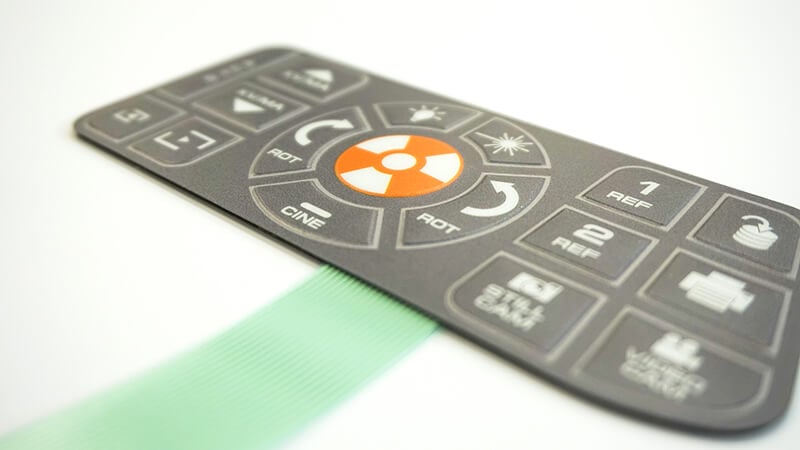Why Choosing the Right Membrane Switch Is Vital for Your Product Design
Why Choosing the Right Membrane Switch Is Vital for Your Product Design
Blog Article
The Duty of Membrane Layer Changes in Enhancing Gadget Usability and Aesthetics
Membrane layer switches stand for a substantial advancement in user interface technology, seamlessly incorporating use with aesthetic charm. Their design is not only functional, supplying receptive controls in a small kind, yet likewise customizable, permitting unique branding and aesthetic engagement. As sectors significantly prioritize individual experience, the implications of these attributes prolong past mere convenience, influencing product style and customer contentment. What remains to be explored is exactly how these components will progress in feedback to emerging fads and technological advancements, shaping the future of human-device interaction.
Recognizing Membrane Layer Switch Modern Technology

The graphic overlay works as the visible surface, often printed with signs and tags that guide customer interaction. Under this layer, the spacer works as a separator, making certain that the conductive layer just makes call when a button is pushed. The conductive layer, normally made from a conductive ink or product, completes the circuit and sends out signals to the device's electronics.
Longevity is a significant benefit of membrane layer buttons, as they are immune to dampness, dust, and impurities, making them ideal for different settings. Furthermore, membrane layer buttons can be customized in terms of form, dimension, and style, enabling makers to tailor interfaces to specific device demands. This adaptability contributes to their prevalent use throughout industries, from consumer electronics to medical tools.
Functionality Advantages of Membrane Buttons
The functionality advantages of membrane layer switches are evident in their intuitive layout and easy to use attributes. These buttons help with simple communication by incorporating responsive comments and recognizable signs, which improve the user experience with clear communication of feature (Membrane Switch). The flat account of membrane layer switches permits simple integration right into various gadgets, lessening the learning contour for users unfamiliar with intricate controls
In addition, membrane switches are frequently created with sensitivity in mind, allowing users to engage with controls effortlessly. This characteristic is especially valuable in environments where fast reactions are critical, such as clinical tools and commercial equipment. Their resistance to dampness and pollutants additionally guarantees trustworthy operation, advertising user confidence in varied settings.
Furthermore, membrane layer switches can be personalized to match certain applications, suiting one-of-a-kind individual demands and choices. This adaptability cultivates a sense of possession among customers, as they can communicate with controls that feel customized to their requirements.
Aesthetic Enhancements Through Layout
Aesthetic improvements play a significant duty in the overall allure and functionality of devices outfitted with membrane buttons. These switches use versatile style possibilities that can be tailored to fulfill brand identification and individual choices. The ability to integrate vibrant colors, tailored graphics, and differed structures permits suppliers read this article to develop visually striking user interfaces that reverberate with users on an emotional degree.
The flexibility of membrane button layout likewise facilitates the have a peek here assimilation of special forms and layouts, contributing to a structured look that enhances the user experience. This not only makes tools extra eye-catching but likewise help in instinctive navigating, as users can easily determine practical locations and controls. In addition, progressed printing technologies allow the reproduction of complex layouts and high-resolution photos, better elevating the visual top quality.
Moreover, making use of backlighting in membrane switches can considerably improve exposure and charm, especially in low-light atmospheres. This mix of aesthetics and functionality fosters an engaging user experience, making devices not just extra enjoyable to make use of however additionally more aligned with modern layout fads. Eventually, aesthetic enhancements through mindful membrane layer button design can transform ordinary tools right into compelling, user-friendly products.
Applications in Numerous Industries
In many industries, membrane layer switches have actually ended up being integral components that enhance capability and functionality across a wide variety of gadgets. These cutting-edge buttons find applications in markets other such as healthcare, consumer electronic devices, vehicle, and commercial tools.
In the healthcare industry, membrane layer buttons are commonly made use of in clinical tools, such as diagnostic tools and patient surveillance systems, where they supply instinctive interfaces that boost customer communication while keeping health. In a similar way, in consumer electronics, membrane switches facilitate user-friendly controls in devices, push-button controls, and gaming gadgets, providing seamless operation and visual allure.

Future Fads in Membrane Layer Buttons
Arising patterns in membrane layer switches are readied to revolutionize interface throughout numerous applications, driven by innovations in innovation and boosting customer needs for capability and style. One noteworthy fad is the consolidation of capacitive touch technology, which supplies an extra receptive and contemporary customer experience contrasted to traditional mechanical switches (Membrane Switch). This shift not only boosts use yet likewise permits for sleeker tool aesthetics
Furthermore, the integration of personalized graphics and backlighting is coming to be significantly popular. Producers are leveraging cutting-edge printing methods and LED innovation to develop aesthetically interesting interfaces that deal with details customer requires while boosting device presence in various lights conditions. This modification cultivates a stronger emotional link in between customers and their tools.

Verdict
In conclusion, membrane changes significantly enhance both use and appearances in modern-day gadgets. Their instinctive style, responsive controls, and customizable graphics help with individual interaction, especially in vibrant atmospheres. Additionally, the unification of vivid shades and backlighting not only elevates visual allure however additionally boosts functionality, allowing for reliable navigation in different lighting problems. As markets proceed to advance, the convenience and ingenious possibility of membrane buttons will likely play a progressively important function in device style and user experience.
Report this page